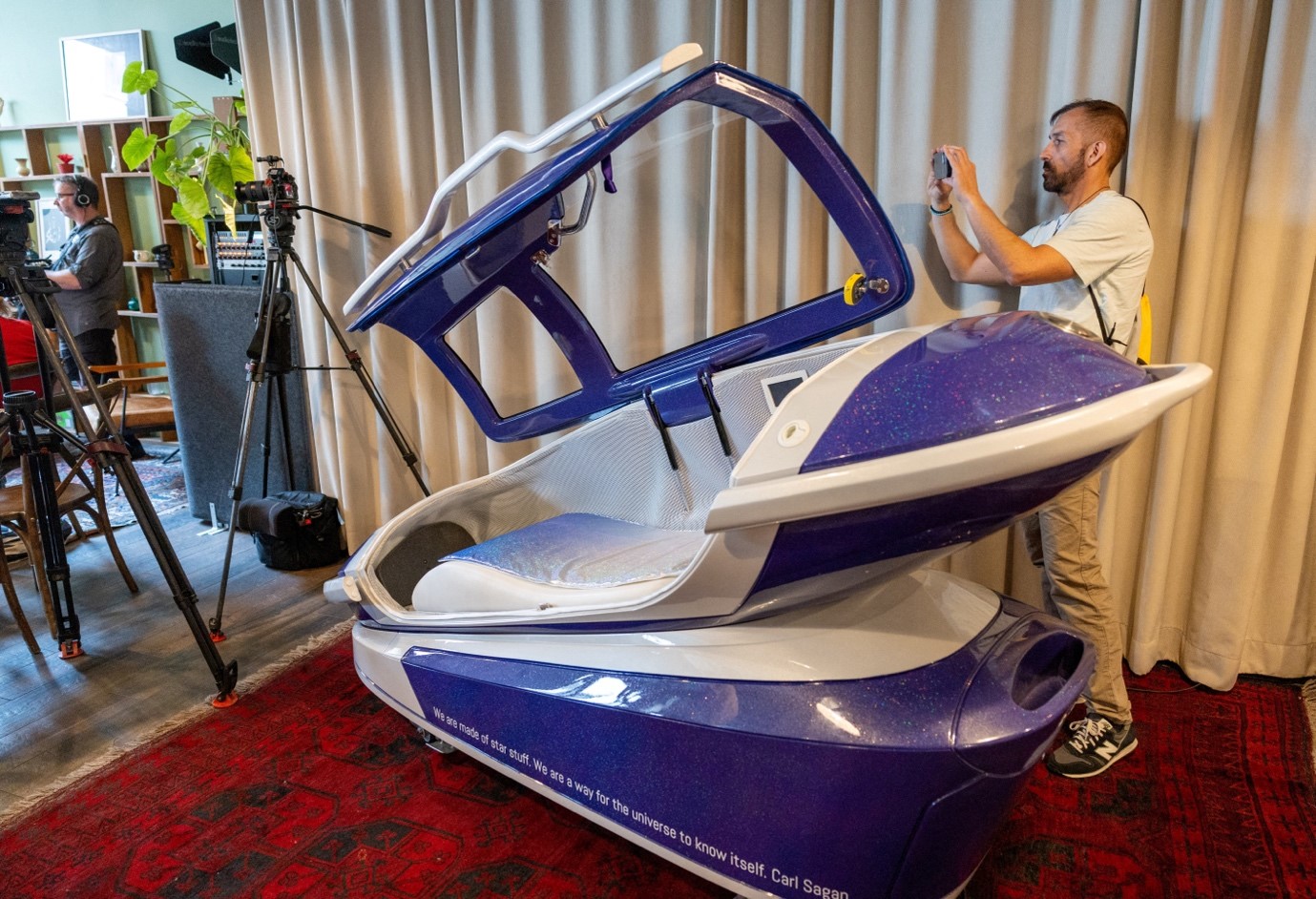By Charalampos Karouzos,
A great reignite in the very controversial debate surrounding the topic of euthanasia has been observed following the recent case involving the “Sarco suicide pod” in Switzerland. As the Reuters firstly reported, the Police force of the northern canton of Schaffhausen bordering Germany proceeded to arrest several people for “inducing and aiding and abetting suicide”, as the “Sarco” capsule had been deployed in a wood in the municipality of Merishausen. The result of the deployment was, as revealed by a spokesperson for the group behind the capsule, The Last Resort, the self-chosen death of a 64-year-old American woman, who had been suffering from a severely compromised immune system. Although The Last Resort described the death as “peaceful, fast, and dignified”, the method used to achieve it has reignited debates about euthanasia, particularly concerning the medical and ethical complexities surrounding the issue.
The technological means through which euthanasia was achieved in this case is the now infamous “Sarco pod”, a novel device designed to allow individuals to end their own lives using nitrogen gas, without requiring the presence of a second individual to activate the device. The recent case has sparked a broader conversation regarding the use of technology in facilitating death, and its consequences, highlighting the need for a deeper reflection on the medical and ethical dimensions of euthanasia.

Euthanasia, as a medical term, refers to the practice of intentionally ending a life to relieve suffering, a deeply divisive topic. While some argue that individuals have the right to choose when and how they die, especially in the context of terminal illness or unbearable pain, others raise concerns about the moral, ethical, and medical implications of assisted death. The Sarco suicide pod, along with many others such recent advancements, exemplifies the technological advances in this space but also raises issues about regulation, mental health, and the potential for misuse.
From a medical perspective, the primary argument in favor of euthanasia is that it allows individuals with terminal illnesses or chronic pain to avoid prolonged suffering, especially if the condition is uncurable. In addition, many proponents of euthanasia believe that people should have the autonomy to decide when their quality of life has diminished to the point where living is no longer a viable or humane option, and thus, by maintaining their dignity, end their life. It must be highlighted that the special nature of the cases where a person’s condition is irreversible and death is inevitable, euthanasia is seen by some as a compassionate choice that can provide a peaceful, dignified end to life.
However, there are significant medical concerns associated with euthanasia, particularly regarding the determination of who is eligible and under what circumstances to take the decision. Physicians are trained to save lives and alleviate suffering, but the idea of actively ending a life —even at the request of the patient— poses a significant conflict with the Hippocratic Oath, which obliges doctors to “do no harm”. Determining when euthanasia is appropriate involves complex assessments of a patient’s mental and physical state, and even with rigorous safeguards, there is always the risk of misjudgment or coercion. In this context, the Sarco pod’s ability to bypass traditional medical settings raises concerns about oversight and the role of healthcare professionals in assisted death.
However, further than the medical concerns, the ethical pivotal questions that surround euthanasia are even more challenging and have formulated one of the central ethical debates of autonomy versus societal responsibility. Advocates argue that individuals should have the right to make personal decisions about their own bodies, including the decision to die. This perspective views euthanasia as an extension of personal freedom, especially when life becomes unbearable due to terminal illness. In the Sarco case, the deceased woman had passed psychiatric evaluations before making her final decision, adding to the narrative that euthanasia is a carefully considered, autonomous choice.
Nevertheless, the ethics of euthanasia extend beyond individual autonomy. Critics worry that normalizing euthanasia could lead to a novel, Pandora’s box, where vulnerable individuals, such as the elderly, disabled, or mentally ill, might feel pressured to choose death, either overtly or subtly, due to societal, familial, or economic burdens. There is also the concern that offering euthanasia as an option could diminish efforts to provide palliative care or support to those who are suffering. If the focus shifts too heavily toward death as a solution, resources that could improve quality of life may become deprioritized.

Another fundamental ethical concern is the potential for misuse. While the Sarco pod was used in Switzerland, a country with a legal framework for assisted suicide from 1942 (!), its availability and the lack of direct medical oversight could raise concerns if similar devices become more widespread. The technology allows for the process to be carried out without medical personnel, relying instead on the individual’s own activation of the mechanism. In theory, this provides autonomy, but it also removes a layer of protection that traditionally exists in euthanasia procedures, where healthcare professionals assess the patient’s condition and ensure that all criteria for assisted death are met.
Moreover, the ethical implications of such technology bring into question the regulation of euthanasia methods. Is it ethical for technology like the Sarco pod to be available to anyone, potentially without the rigorous safeguards that typically accompany euthanasia decisions? How can governments and medical institutions ensure that such devices are not misused or accessed by individuals who are not in the right mental state to make life-and-death decisions? The case of the American woman who used the Sarco pod raises these issues, as it underscores the potential for legal and ethical gray areas in the rapidly advancing field of euthanasia technology.
Ultimately, the discussion surrounding euthanasia requires a balance between respecting individual autonomy and protecting vulnerable populations. It can be clearly observed that while novel technological advancements present new possibilities for those seeking control over their deaths, however it also introduces a host of ethical and medical challenges. As euthanasia becomes a more prominent option in medical care, particularly in countries where it is legal, society must ensure that robust frameworks are in place to prevent misuse and to protect those who may be at risk of coercion or exploitation.
Euthanasia, without a doubt, is not a decision that should be made lightly, and while the desire to relieve suffering is understandable and ethical justifiable, it is critical that this practice remains tightly regulated and ethically sound. The Sarco case serves as a great reminder that while we have the ability to develop technological solutions to end life, we must also carefully reflect on the broader implications of offering such options, which may conflict with our human instincts and ethical values. The only way that appears to be fruitful in aiming to navigate the plethora of ethical and medical dilemmas that surround the issue of euthanasia is a careful consideration of both medical and ethical factors in a legal environment that protects the right of people to choose a dignified death and safeguards life as a fundamental value for humanity.
References
- Several arrested after American woman dies in first use of controversial suicide pod. CNN. Available here
- Factbox: Status of euthanasia, assisted suicide in Europe. Reuters. Available here
- Swiss police make arrests after suicide capsule is used for first time. Reuters. Available here
- Switzerland. CAMPAIGN FOR DIGNITY IN DYING. Available here
- Euthanasia: Right to life vs right to die. NIH. Available here
- ‘Euthanasia: Right to Die with Dignity’. NIH. Available here




